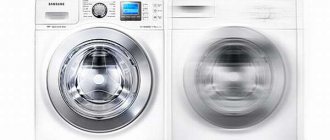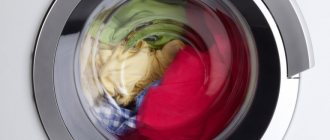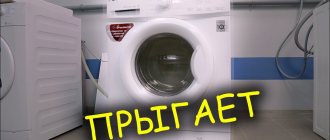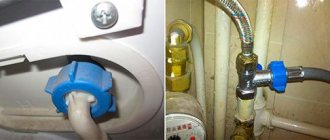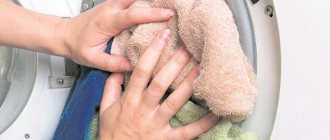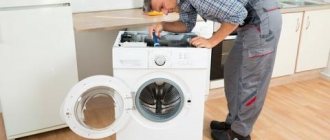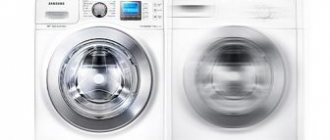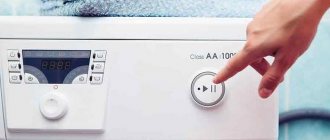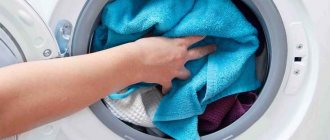During operation, the washing machine emits a steady hum, which intensifies during spinning and drying.
For user convenience, LG indicates noise standards at various stages of the cycle. If the noise is significantly stronger than stated, this may indicate a malfunction of the engine and rotating mechanism.
Read on to find out why your LG washing machine makes a lot of noise when spinning, how to detect the problem and fix it.
In what cases is noise at high speeds normal?
Engine operation and drum rotation at high speeds cannot be silent. During spinning, the sound intensity increases, and its maximum value will depend on several factors:
- quantity and distribution of laundry in the tank;
- machine design (type of transmission, presence of counterweight, etc.);
- washing programs, speed;
- unit models.
The average background noise of LG brand automatic washing machines (WMAs) is 54-55 dB during the main wash cycle and 74-76 dB during the spin cycle.
A noise level of 75 dB is approximately equivalent to screaming or laughing nearby, or a medium-power vacuum cleaner running. What should not alarm the owner:
- The hum of the motor when the drum rotates (both during washing and spinning).
- The noise of the drum itself while spinning clothes.
- Increases sound when turning on higher speeds.
Supported range of Bosch washing machines
See the list of models below:
The MAXX 4 series includes two common modifications - Speed Edition and Speed Perfect.
The most popular models of them are:
W.F.C.
2062 OE, WFC 1664 OE, WFC 1666 OE, WFC 1665 OE, WFC 1667 OE, WFC 2060, WFC 1262 OE, WFC 1263 OE, WFC 1600 BY, WFC 1662 OE, WFC 1663 OE, WFC 2066 OE, WFC 2063 OE , WFC 2064 OE, WFC 2065 OE, WFC 2067 OE.
WLF
16180 OE, WLF 20180 OE, WLF 20181 CE, WLF 20164 OE, WLF 16060 OE, WLF 16062 BY, WLF 16164 OE, WLF 20060 OE, WLF 20170 CE, WLF 20271 CE, WLF 20281 CE, WLF 242 71 CE, WLF 16170 CE , WLF 16260 OE, WLF 16165 CE, WLF 16261 OE, WLF 20062 BY, WLF 20160 OE, WLF 20171 CE, WLF 20260 OE, WLF 20261 OE.
WFO
1640 OE, WFO 1261 PL, WFO 2050 GR, WFO 1661 BY, WFO 1662, WFO 2040 OE, WFO 2042 OE, WFO 2051 GR, WFO 2060 BY, WFO 2064, WFO 2264, WFO 2440 OE, WFO 2442 OE, WFO 2 450 , WFO 2451 GR, WFO 2464, WFO 2840 OE, WFO 2864, WFO 1660 BY.
WFR
2440, WFR 2441, WFR 2466, WFR 2830, WFR 2841, WFR 2866, WFR 3240.
WFH
2061 OE, WFH 1660 OE, WFH 2461 OE, WFH 1260 OE, WFH 1262, WFH 2060 BY, WFH 2460 OE, WFH 2062 OE.
The SpeedPerfect and SilencePerfect modifications are the highlight of the MAXX5 series.
Main model range:
WLX
20462 OE, WLX 2048K OE, WLX 20362 OE, WLX 20364 OE, WLX 20161 OE, WLX 16163 OE, WLX 20160 OE, WLX 2036 KOE, WLX 20361 OE, WLX 20480 OE, WLX 2046 1 OE, WLX 20370 CE, WLX 24460 OE , WLX 24363 OE, WLX 20460 OE, WLX 24361 OE, WLX 24362 OE, WLX 24462 OE, WLX 24463 OE, WLX 2448 KOE, WLX 20162 OE, WLX 24163 OE, WLX 20363 OE, WLX 24364 OE, WLX 16162 OE, WLX 20463 OE, WLX 16161 OE, WLX 16160 OE, WLX 20163 OE, WLX 24461 OE, WLX 24360 OE.
W.V.D.
24520 EU, WVD 2446 SOE, WVD 24460 OE, WVF 2400 EU, WVF 2401, WVT 1260, WVTI 2841 EU, WVIT 2842 EU, WVT 3230, WVD 24420 OE, WVTI 3240 EU, WVTI 2840 EU, WVTI 28 42 EU.
Main model range:
W.A.E.
2037 KOE, WAE 16160 OE, WAE 20440 OE, WAE 24160 OE, WAE 24360 OE, WAE 24440 OE, WAE 20360 OE, WAE 20370 OE, WAE 16440 OE, WAE 20160 OE.
Main model range:
W.A.E.
24463 OE, WAE 24164 OE, WAE 24467 OE, WAE 24443 OE, WAE 2049 KOE, WAE 16161 OE, WAE 20161 OE, WAE 20163 OE, WAE 20164 OE, WAE 20361 OE, WAE 2444 1 OE, WAE 24466 OE, WAE 16442 OE , WAE 20364 OE, WAE 2047 SOE, WAE 24163 OE, WAE 24468 OE, WAE 20363 OE, WAE 16443 OE, WAE 24444 OE, WAE 24462 OE, WAE 24364 OE, WAE 16163 OE, WAE 24442 OE, WAE 28444 OE, WAE 28443 OE, WAE 28441 OE, WAE 24361 OE, WAE 20443 OE, WAE 24363 OE, WAE 20362 OE, WAE 24464 OE, WAE 20442 OE, WAE 16441 OE, WAE 20441 OE, WAE 244 65 OE, WAE 2046 SOE, WAE 20444 OE , WAE 16444 OE, WAE 2044 SOE.
Vario Perfect translated from German means ideal quality. Sensitive - sensitive wash. These two qualities combine in the latest line of Bosch LOGIXX washing machines.
Model range of the Logic 6 series.
WLM
20440 OE, WLM 20441 OE, WLM 24440 OE, WLM 2445 SOE, WLM 2444 SOE, WLM 24441 OE.
WAQ*
20440 OE, WAQ 24440 OE, WAQ 24460 OE, WAQ 24461 SNOE, WAQ 28440 OE, WAQ 28460 SNOE. (*AVANTIXX)
Model range Logic 7.
WIS 24140 OE and WIS 28440 OE
Model range Logic 8.
W.A.S.
20443 OE, WAS 2474 GOE, WAS 24740 OE, WAS 2044 GOE, WAS 2875 BOE, WAS 24440 OE, WAS 24442 OE, WAS 24741 OE, WAS 28743 OE, WAS 20440 OE, WAS 24742 OE, WAS 24743 OE, WAS 28740 OE , WAS 28741 OE, WAS 24443 OE, WAS 2876 BOE, WAS 24441 OE, WAS 28742 OE, WAS 20442 OE, WAS 20441 OE, WAS 28750 OE.
Signs of damage
The following signs may indicate a breakdown in the SMA mechanism
rumble, strong vibration during spinning;- “jumping”, displacement of the machine when rotating at high speeds;
- the appearance of crackling, grinding, squeaking and other extraneous sounds;
- increased noise compared to what was before;
- poor quality of washing (wet laundry after spinning, stains, etc.);
- drum jamming in one position;
- flow.
If you ignore these symptoms, then over time the SMA may completely stop spinning the drum.
Simple misunderstanding
What to do if you discover that a machine that was started 20 minutes ago is still standing empty, and at the same time it is making an incomprehensible hum. Firstly, it is worth checking whether the water supply in the house has been turned off. Open the tap in the bathroom or kitchen, if there is pressure and it is sufficient, you will have to inspect the machine.
Make sure the hatch is closed. If the door is open, the locking device will not work and the machine will not start drawing water. If outwardly there are no problems, you will have to “sweep aside” typical faults one by one.
Diagnostics should be carried out from simple to complex; first, the inlet valve, filter mesh are checked, then the pressure switch and pump, and finally the control module.
Before using the washing machine, be sure to turn off the power. Unplug the power cord from the outlet. You also need to remember to turn off the tap responsible for the water supply. First of all, the inlet hose and filter mesh are checked for blockages. You need to do this:
- loosen the clamp - this will help unhook the inlet hose from the machine body;
- disconnect the “sleeve” from the water pipe;
- inspect the hose, rinse it under the tap;
- find the filter element, it is installed at the point where the inlet hose is connected to the inlet valve;
- Grasp the protrusion of the mesh with pliers and pull out the filter;
- clean the filter element,
- install the mesh back;
- Reconnect the inlet hose.
You should also check the filter mounted in the pipe. It is installed in front of the shut-off valve. This element is responsible for the primary, “rough” purification of tap water, so it is on it that a lot of debris and impurities settle.
Article on the topic: How to restart a washing machine
To wash the coarse filter, you should use one wrench to fix the joint, and with the second, unscrew the nut holding the flywheel. Be sure to place a container nearby. When the fastener is unscrewed, water will flow out of the pipe. A powerful jet will clean the mesh, washing away all debris. Afterwards all the elements are put into place.
Differences between direct and belt drive washers
Rotational motion can be transmitted from the motor to the drum shaft through a belt or electromagnetic system. LG owns a patent for Direct Drive technology, which is installed on most modern washing machines.
In a belt-driven SMA, the motor shaft is connected to the drum pulley using a narrow rubber belt. The intensity of rotation is controlled by the tachogenerator and motor brushes. Units with such a mechanism are usually noisier due to the large number of connecting elements.
In a direct drive SMA, the speed is set by an electromagnetic system , and the inverter motor rotates the drum without direct contact with it. This allows you to eliminate some breakdowns (for example, belt stretching, brush wear), increase the maximum speed and increase the tank load.
With identical technical characteristics, the inverter SMA promises to be quieter than the belt one. Due to the reliability of the direct drive, the risk of abnormal noise during spinning is also lower.
The belt drive also has an important advantage: if the weight is unevenly distributed in the tank, the rubber belt acts as an additional shock absorber. Direct drive mechanisms are more sensitive to uneven load distribution in the drum.
The water supply tap is closed or there is low pressure in the water supply
New type washing machines must have a water shut-off tap. As a rule, its valve is located directly on the pipe or on the comb. It is clear that if the tap is closed, water will not flow into the car. At the same time, the unit hums, and an error is displayed on the display.
It is quite easy to fix such a “breakdown”, just press the pause button, open the valve and start the machine again.
If the tap is open, but water does not flow into the washing machine or it fills slowly, then there may be a problem in the water supply: there is no water or the pressure in the pipes is not strong enough. Open any tap in the bathroom and check for availability. Call the hotline of your housing office and find out the timing of water supply. Of course, you will have to postpone washing for this time.
Article on the topic: Where to pour washing gel into a Samsung washing machine
Possible causes of problems, diagnosis and repair
The reasons for loud noise when spinning clothes can be :
- errors in installing the machine,
- shock absorber problems,
- wear of bearings, etc.
Installation on an uneven or unstable surface
If the unit is not level or on an unstable area, then vibration of the body during washing will lead to rocking and increased noise.
To balance the load, the washing machine is installed using a building level. The gap between its sides and the walls should be at least 2-3 cm .
To reduce noise during spinning, you can purchase or make anti-vibration pads for the legs made of plastic or thick rubber.
Availability of transportation bolts
To avoid damage to the springs during transportation, the manufacturer secures the tank with special bolts. When installing, additional fasteners are removed .
If you do not unscrew the transport bolts, then during the spin cycle the machine will begin to make a lot of noise, move and vibrate. To reduce noise, it is necessary to remove the back wall of the unit and unscrew the fasteners that firmly fix the tank. In operating mode, it should balance freely on the springs.
Operating the SMA with shipping bolts may damage the tank.
Missing or damaged counterweight
To balance the heavy drum with laundry during spinning, counterweights are attached to it. They are light gray blocks that are located under the tank. Problems with counterweights are accompanied by strong noise and vibration at high speeds.
To check, it is necessary to remove the side wall of the MCA and inspect the blocks and fasteners. If the counterweights are damaged, they are replaced with new ones ; if the fastenings are loosened, they are tightened.
Early models of LG direct drive machines do not have a built-in counterweight, so when replacing a homemade unit, you will have to use similar parts from units of other brands (for example, Indesit).
Foreign object entering the tank
Foreign objects that get inside the drum usually end up in the drain filter.
However, even the smallest parts can get inside the tank . When the drum rotates, they hit the embossed wall, producing knocks, clanging and ringing.
Most often, stuck objects are found under the heating element (heating element), between the tank and the drum, or in the perforation of the latter.
If a small part is partially inside, you can remove it with pliers or tweezers. You can get it from the bottom of the tank through the hole for the heating element . In cases where objects get stuck on the side or top of the container, machine owners have to resort to the help of a technician.
Parts made of metal and hard plastic can damage the coating of the heating element, the walls of the tank and the drainage system, so it is prohibited to continue washing if noise occurs.
Malfunction of springs or shock absorbers
The SMA tank is suspended on 2-4 springs , which dampen vibration and allow the tank to move only in one plane.
If one of the parts stretches, falls off or bursts, then the balance of the system is disrupted. During the washing and spinning process, the loose tank will vibrate strongly and knock on the inner wall of the machine.
Most often, the springs do not break, but jump out of their seat. In this case, they are secured back. If damaged, the unit must be disassembled and spare parts replaced.
Shock absorbers dampen drum vibration . If they are damaged, the washing machine begins to knock heavily, vibrate and “jump” during the spin cycle. The service life of shock absorbers largely depends on compliance with the recommendations for loading the drum.
Springs and shock absorbers are replaced only as a set, since replacing one part will lead to an imbalance in the tank. Read about replacing shock absorbers here.
Breakage of the rotation shaft or pulley
Damage to the rotating shaft is a rare malfunction in LG washing machines. As a rule, it occurs due to a manufacturing defect or bearing failure.
The main signs of a shaft defect are loud noise during spinning and drum play. In an SMA with a belt drive, the pulley mount may become loose. This also leads to play and increased noise.
During the rotation of the drum, extraneous knocking noises are heard, which become more frequent during the spin cycle. For repairs, simply remove the rear wall of the machine and tighten the pulley nut .
A knock on the back wall of the unit can also occur when the noise filter, a small part that is attached to the power cord inside the unit, is loosened.
Bearing wear
Bearings are the most loaded and precise part of a washing machine. When they are exhausted, the unit begins to rattle, knock and vibrate strongly. The problem gets worse as the speed increases.
If the part is damaged and critically worn, the SMA will stop pressing or the drum will jam . The problem may be accompanied by leakage of the machine and the appearance of rusty spots on things. To eliminate the noise, you will need to replace the oil seal and bearings. Read how to do this here.
Washing machine repair specialists do not recommend installing new spare parts yourself, since this will require complete disassembly of the unit.
The video will tell you about replacing bearings:
The machine does not turn, but takes in water
Why does the machine take in water, but the drum does not rotate? Immediately drain the water and try turning the drum by hand. If it doesn't turn by hand, it's probably jammed.
For what reasons did the problem occur:
- The drive belt has broken or fallen off and is wrapped around the pulley. This was the reason for the jamming.
- An object is stuck between the tank and drum. It could be any items that fell out of the pockets.
- The drum bearing has deteriorated, so it cannot rotate normally.
In most cases, bearings fail due to prolonged use, overloading of the drum, or if the seal has never been lubricated.
Loose Counterweight
The counterweight is a very simple device in the washing machine that can be the cause of the noise. Actually, this is a piece of concrete installed inside the washing machine. Its task is to dampen the inertia that arises during the rotation of the drum. Despite its apparent simplicity, it can become loose and, instead of calming the vibration of the car, bother its owner with creaks and noise.
The counterweight is easy to access - you just need to remove the top cover. Often, during operation, the mounting holes break, and the concrete block begins to “walk”, making a loud noise. If the counterweight moves freely, but the bolts cannot hold it because the holes are larger than the bolt heads, the counterweight will have to be replaced.
Foreign object hit
Very often, the reason why the machine starts to hum is that small objects get into the drum: coins, garbage, buttons and even lightning. When washing, they get clogged between the drum and the tub, thereby creating a hum and grinding noise. You can solve the problem yourself by stopping washing and turning off the machine, removing the heating element and examining the space for the presence of foreign objects. They need to be removed and the heating element returned to its place. Small items can also get into the sump located next to the filter, so you need to check that too. The sump cover is often located in the lower corner of the machine; you should remove it and remove any foreign objects. If after cleaning the machine continues to make uncharacteristic noise, diagnostics should be continued.
Noise due to improper installation
If the washing machine makes noise on the first day after purchase, it is logical to assume that it was installed incorrectly. It is likely that to correct the situation, it is enough to simply level it by twisting the legs.
In order for the machine to work for a long time, not vibrate and not make unnecessary noise, during installation you need to pay attention to a number of significant points.
- Make sure that the transport bolts are unscrewed. Quite often, beginners who install the machine themselves simply forget about them.
- The floor on which the washing machine is installed must be level and durable. Do not operate the washing machine on a shaky, creaky floor.
- It is important to adjust the legs correctly. If necessary, you can use special anti-vibration inserts.
Even if the washing machine has been operating for some time, before you start looking for the cause of excessive noise inside it, it would be a good idea to make sure that it is stable and installed correctly.
The drum rubs against the rubber cuff
If all parts of the washing machine are in working order, but noise is still heard during washing, you should check the condition of the sealing collar. It often does not fit in size, so when washing it rubs against the lid and creates an unpleasant noise. The fact that the noise is caused by cuff friction is the presence of pieces of rubber on the surface of the cover. In this case, it is necessary to replace the cuff with a suitable one. You can also attach a piece of sandpaper to the side of the drum and turn on the spin mode. The sandpaper will erase the excess rubber, which will allow you to achieve the required cuff size. Don’t forget about cleaning the machine from rubber residues, so after spinning it’s worth turning on the rinse mode and then cleaning the filter.
How to diagnose a device at home
You can do the initial diagnosis yourself. If excessive noise is detected, you should immediately stop using the machine, otherwise the situation will only get worse.
Washing machine inspection and repair
Professionals suggest the following repair procedure:
- Unplug.
- Remove the back wall.
- Carefully examine and examine.
- Carry out a full diagnosis.
- Replace damaged parts.
- Put the machine back together.
